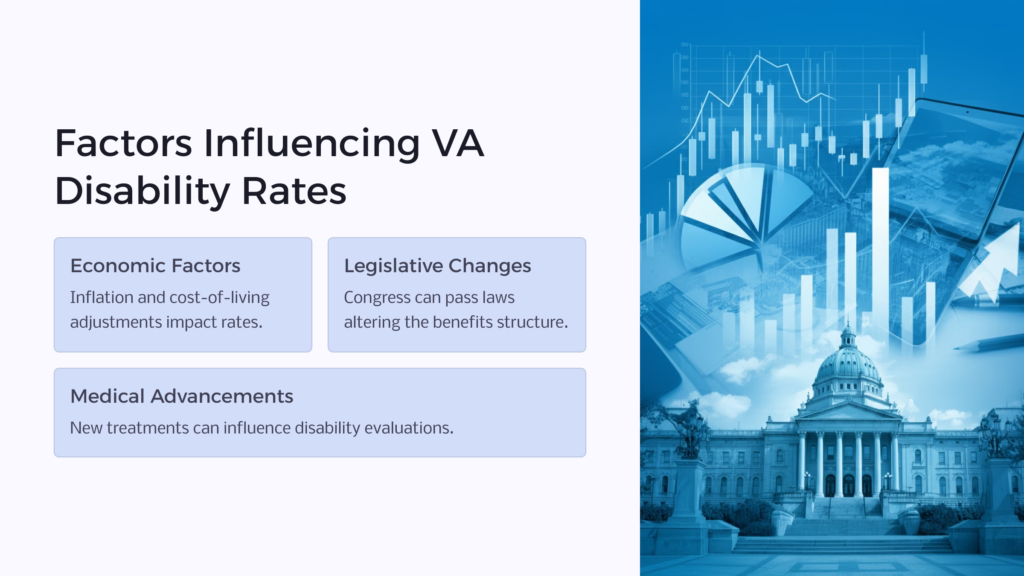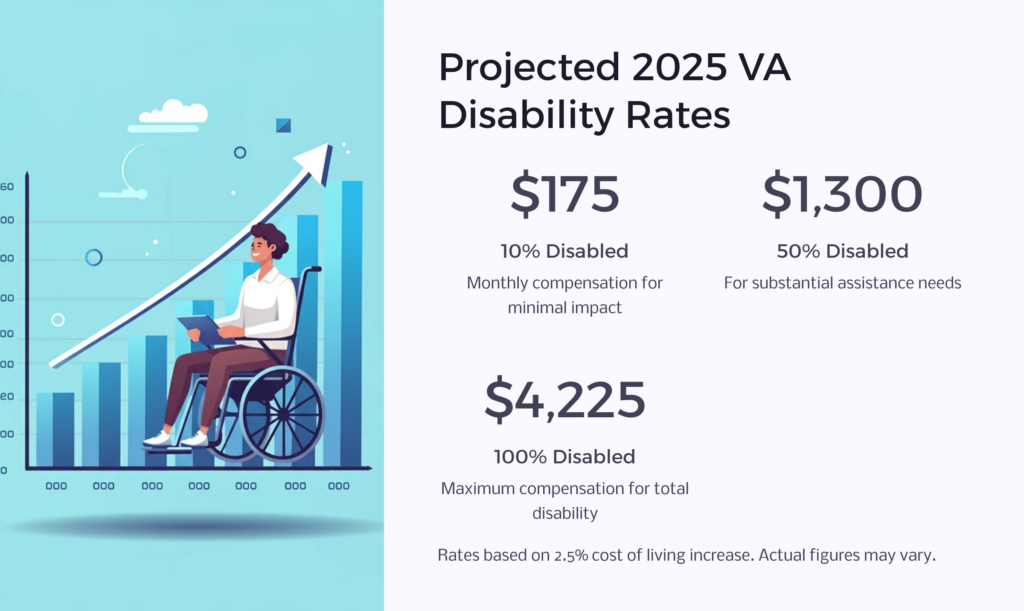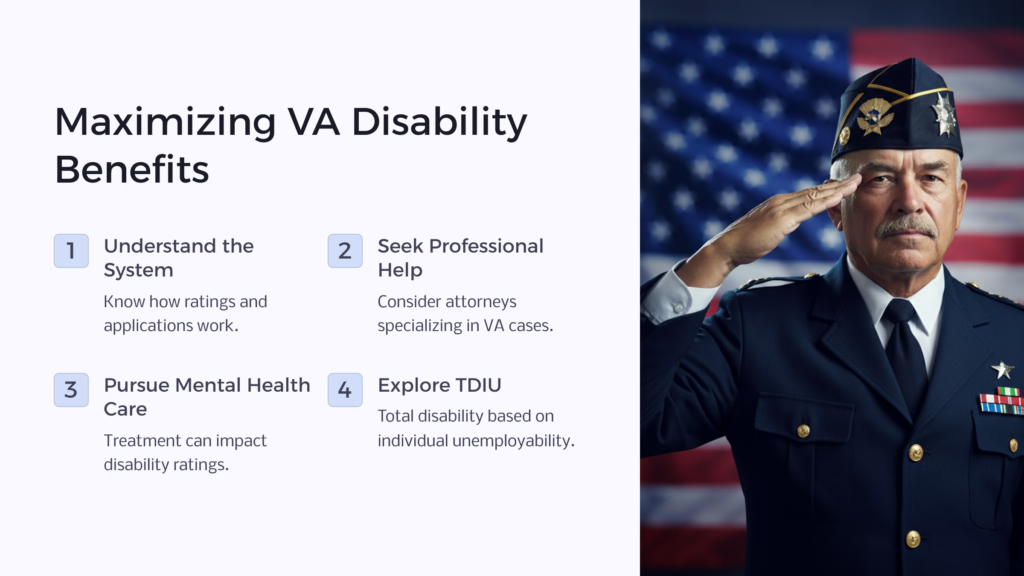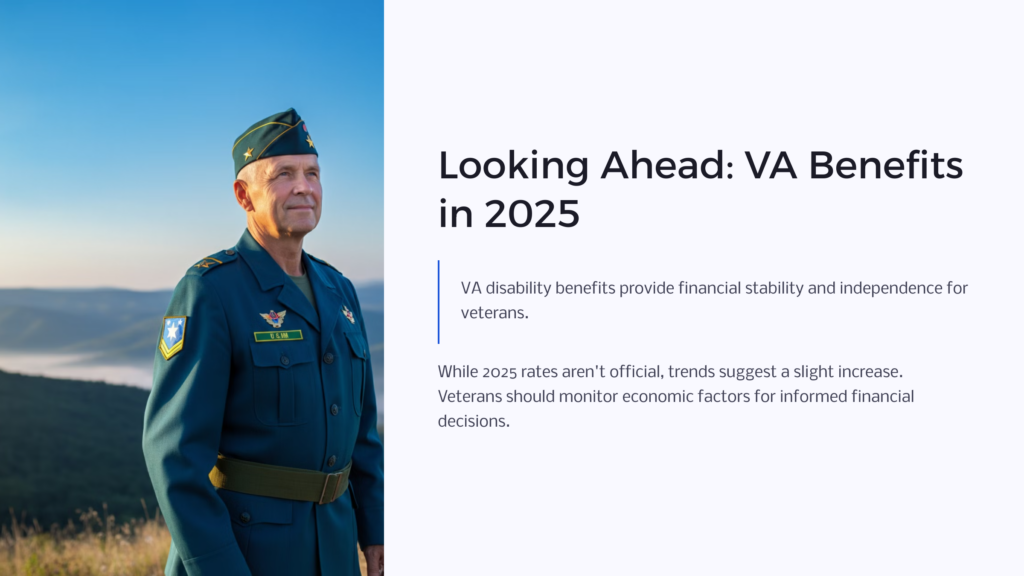Veterans deserve a debt of gratitude from the government and everyday citizens and we are obligated to help them any way we can. This obligation is even greater for vets injured in the line of duty or as a result of serving our country. Disabilities are taken seriously by the Department of Veterans Affairs (VA) and it has created a rating system to quantify the percentage of a vet’s life impacted by illness or injury. This system ranges from 0% for no disability to 100% for those who are totally disabled. This percentage is used to determine the monthly compensation amount and directly impacts the financial well-being and quality of life of disabled veterans and their families.
VA disability rates change every year and this change is based on a variety of factors. These include inflation, economic conditions, and legislative changes. These are reflected in the annual cost of living increases. While the 2025 rates have not been announced just yet, over the past several years, disability cost of living percentages typically range from 1 to 3%.
Forecasted rates can change, but understanding them can give you valuable insight when planning for your financial future.
Background
The VA disability rating system determines the monthly compensation paid to veterans who were injured or developed medical conditions as a result of their military service. The levels are calculated based on the severity of the condition and expressed as a percentage. The higher the percentage, the more impact a disability has on a veteran’s quality of life and the greater the compensation.

Aside from the percentage of disability, there are other factors that determine the amount of money a disabled vet will receive each month. Some of these include:
- Economic Factors: Things like Inflation and cost-of-living adjustments (COLA) are the main economic drivers that affect the rates. As the cost of living increases, so do the disability rates, to ensure veterans can maintain their standard of living.
- Legislative Changes: Congress can pass laws that change the benefits structure, either increasing or decreasing the rates.
- Medical Advancements: Improvements in medical treatments can influence how disabilities are evaluated, potentially leading to changes in rating percentages.
Historically, VA disability rates have seen incremental increases aligning with inflation and cost-of-living adjustments. For example, in the past decade, rates have typically risen by 1-3% annually. This trend reflects the ongoing need to adjust benefits to keep pace with the economic realities faced by veterans.
Projected VA Disability Rates in 2025

As we look towards 2025, the VA disability rates are expected to continue reflecting economic conditions, particularly inflation and cost-of-living increases. Below are the projected monthly rates for each percentage category based on a 2.5% cost of living increase and a single spouse/parent but no children:
- 10% Disabled: Veterans rated at 10% disability are projected to receive a monthly compensation of around $175. At this level, the compensation doesn’t change with fewer or greater dependents.
- 20% Disabled: With a 20% disability rating compensation rises to approximately $350 per month. This level will also not see an increase based on number of dependents.
- 30% Disabled: For those rated at 30%, the monthly compensation might range from $537 to $600. Veterans in this category often face more significant impacts on their daily lives, necessitating greater financial support.
- 40% Disabled: Veterans with a 40% disability rating could expect their compensation to rise to around $775 to $925 per month. This category begins to reflect more severe disabilities that significantly affect the veteran’s ability to work and engage in daily activities.
- 50% Disabled: A 50% disability rating might expect monthly compensation of approximately $1,100 to $1,300. Veterans in this group often require more substantial assistance and accommodations due to the severity of their conditions.
- 60% Disabled: Veterans rated at 60% could see their monthly benefits increase to about $1,400 to $1,625. This level of disability often corresponds with considerable challenges in maintaining employment and managing daily living.
- 70% Disabled: With a 70% disability rating, compensation of around $1,750 to $2,025 per month. This reflects a high level of disability, with significant implications for quality of life.
- 80% Disabled: Veterans with an 80% disability rating could expect compensation in the range of $2,050 to $2,350 per month. At this level, disabilities are severe and typically require extensive medical care and assistance.
- 90% Disabled: A 90% disability rating might result in a monthly compensation of approximately $2300 to $2,650. Veterans in this category often experience profound challenges in most areas of life, necessitating comprehensive support.
- 100% Disabled:
Veterans who are 100% disabled are projected to receive around $3,800 to $4,225 per month by 2025. This reflects total disability, where veterans are unable to work and require full-time care or support.
As a reminder, these are just estimated figures for 2025. There are still many things that can impact these numbers before the final dollar amounts are announced, typically in December of the year before. The number and type of dependent will also have an impact on the monthly amount a veteran will receive.
Factors Influencing 2025 Forecast
It’s common for VA disability rates to mirror current economic conditions. If history holds true, 2025 rates should reflect a steady rise in rates, but until all the factors are considered, these trends are just predictions and educated guesses. The following things must be considered before rates are finalized.
Economic Factors
Since the VA disability system was designed to help veterans suffering as a result of their military service, it only makes sense for the disability rates to be impacted by the current economic trends. Higher inflation rates mean less spending power. By increasing the disability rates, vets can offset its impact on their lives.
Inflation rates are directly related to cost-of-living adjustments (COLA). These are applied to most government payment programs like Social Security, Social Security Disability, and the VA disability benefits program. If trends hold, the 2025 increase could be substantial compared to recent years. The current inflation rate is just under 3% but may vary drastically before the final COLA numbers are determined.
Political Factors
In November, Americans will go to the polls and elect a new president as well as vote for a third of the Senate seats and all of the House seats. This can lead to a political shift that could impact veterans’ benefits. Different fiscal concerns can come into play.
In addition, new policies and reforms can impact veterans’ benefits. For example, changes in how disabilities are defined can lead to changes in compensation rates. Supporting advocacy groups that push for positive changes in policies that impact veterans affairs.
Technological Factors
Technology is advancing every day, and with this advancement comes new ways to treat diseases and injuries. For example, a new type of prosthetic can make an amputee more mobile and independent so he or she could lead a more normal life, This could impact their disability rating.
Other advancements in medicine could lead to better outcomes. New pharmaceuticals, treatment plans, and surgical techniques are all things that can impact the compensation a vet could receive from the VA disability program.
Societal trends
The growing number of veterans requiring disability compensation will likely influence the 2025 rates. As more veterans enter the system, there may be increased advocacy for higher rates to ensure adequate support.
Also, changes in overall health trends among veterans, such as rising rates of mental health conditions, will affect disability rates. Improved standards of care and greater recognition of certain conditions may lead to higher compensation levels.
Medical and Health Factors
Another area that’s showing advancement is in the standards of patient care. These can drastically improve outcomes for veterans suffering from a variety of illnesses, They can also impact the disability ratings.
Once everything is factored in, the VA will typically announce the disability rates on its website in December.
Potential Impact on Veterans
The projected increase in VA disability rates for 2025 could have significant financial implications for veterans. Higher rates will provide greater financial stability, allowing veterans to cover living expenses, medical costs, and other necessities.
Higher compensation can also allow for more opportunities for rehabilitation and greater independence. It can make essential services more affordable for veterans. These include such things as home modifications, personal care, and specialized equipment.
Having a stable income each month that a veteran can count on is also a benefit for them. It makes financial planning easier and provides peace of mind.
Ways to Maximize VA Disability Benefits

For veterans making use of VA disability benefits, it’s important to know how to get every dollar you are eligible for and that means knowing how the system works. Each diagnosed illness or injury has a rating and that’s your first place to start. From the application to the appeals process to the re-evaluation options, knowing how the system works can help you maximize your benefits.
If you still need more help, find a reputable and knowledgeable attorney or representative who specializes in VA disability cases. They can help you navigate the often complex process of obtaining all the benefits you deserve.
Another avenue of care that is thankfully opening up for veterans is mental health care. Pursuing this treatment for these disorders can impact the patient’s disability rating percentage.
If you or a vet you know is unable to work, you need to file for total disability, the process is a little different, and here again, an experienced lawyer might be helpful. The actual term is total disability based on individual unemployability (TDIU). This can allow you to claim compensation at the 100% level even if your disability rating is less than that.
Conclusion

VA disability benefits are often a lifeline for military personnel who have been injured or gotten sick as a result of their service to our country. To make sure you get the maximum benefits be sure you understand what the different rating levels mean and how to determine which level is right for your situation. These benefits can give vets financial stability and independence so they can take care of their families and live their best lives.
While the 2025 rates aren’t official yet, history and current economic and political factors point to a slight increase in the cost-of-living adjustment that will be applied starting in January. Veterans who rely on these benefits should keep a close eye on where factors like the inflation rate are going so they can make educated decisions about their finances.
 Benefits.com Advisors
Benefits.com Advisors
With expertise spanning local, state, and federal benefit programs, our team is dedicated to guiding individuals towards the perfect program tailored to their unique circumstances.
Rise to the top with Peak Benefits!
Join our Peak Benefits Newsletter for the latest news, resources, and offers on all things government benefits.



















